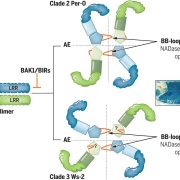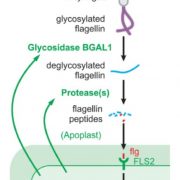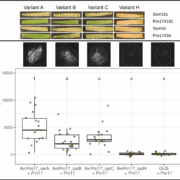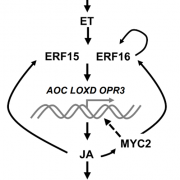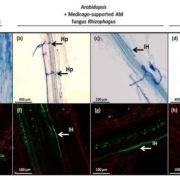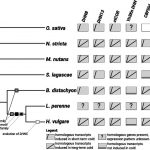The EDS1-SAG101 complex regulates TNL-based immunity in Solanaceous plants (Plant Cell)
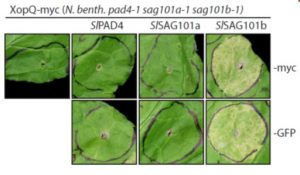 Microbial pathogens secrete virulence effector proteins into host cells to suppress basal plant defenses. Plant resistance (R) receptors induce robust immune signaling after directly or indirectly detect such effector-mediated host manipulation. In Arabidopsis, immunity transduced through many TNL (TIR-NBS-LRR) class R receptors requires heterodimeric complexes consisting of the lipase-like EDS1 (Enhanced Disease Resistance1) and sequence-related homologs PAD4 (Phytoalexin Deficient4) or, to a lesser degree, SAG101 (Senescence Associated Gene101). In a new study, Gantner et al. explore this paradigm using functional genomic techniques in Nicotiana benthamiana. CRISPR/Cas9-generated knockouts of eds1 family genes supported a conserved role for NbEDS1 in regulating Roq1 (TNL) immunity activated by the XopQ effector from the bacterial pathogen Xanthomonas campestris. Surprisingly, the SAG101b isoform, and not PAD4 or SAG101a, was required to form functional TNL immune-competent EDS1-SAG101 complexes. Cross species complementation assays further revealed a strict dependency for intra-species (from Arabidopsis or tomato) EDS1-PAD4 pairs in Arabidopsis, whereas AtEDS1-AtSAG101 was not transferable to N. benthamiana. Genetic chimeras between SAG101b (functional) and SAG101a (non-functional) revealed an apolar patch of amino acid residues within the EP domain that was essential for TNL immunity. Collectively, this work provides novel insights into the functional diversity of TNL immune signalling mechanisms in flowering plants. (Summary by Phil Carella) Plant Cell 10.1105/tpc.19.00099
Microbial pathogens secrete virulence effector proteins into host cells to suppress basal plant defenses. Plant resistance (R) receptors induce robust immune signaling after directly or indirectly detect such effector-mediated host manipulation. In Arabidopsis, immunity transduced through many TNL (TIR-NBS-LRR) class R receptors requires heterodimeric complexes consisting of the lipase-like EDS1 (Enhanced Disease Resistance1) and sequence-related homologs PAD4 (Phytoalexin Deficient4) or, to a lesser degree, SAG101 (Senescence Associated Gene101). In a new study, Gantner et al. explore this paradigm using functional genomic techniques in Nicotiana benthamiana. CRISPR/Cas9-generated knockouts of eds1 family genes supported a conserved role for NbEDS1 in regulating Roq1 (TNL) immunity activated by the XopQ effector from the bacterial pathogen Xanthomonas campestris. Surprisingly, the SAG101b isoform, and not PAD4 or SAG101a, was required to form functional TNL immune-competent EDS1-SAG101 complexes. Cross species complementation assays further revealed a strict dependency for intra-species (from Arabidopsis or tomato) EDS1-PAD4 pairs in Arabidopsis, whereas AtEDS1-AtSAG101 was not transferable to N. benthamiana. Genetic chimeras between SAG101b (functional) and SAG101a (non-functional) revealed an apolar patch of amino acid residues within the EP domain that was essential for TNL immunity. Collectively, this work provides novel insights into the functional diversity of TNL immune signalling mechanisms in flowering plants. (Summary by Phil Carella) Plant Cell 10.1105/tpc.19.00099


